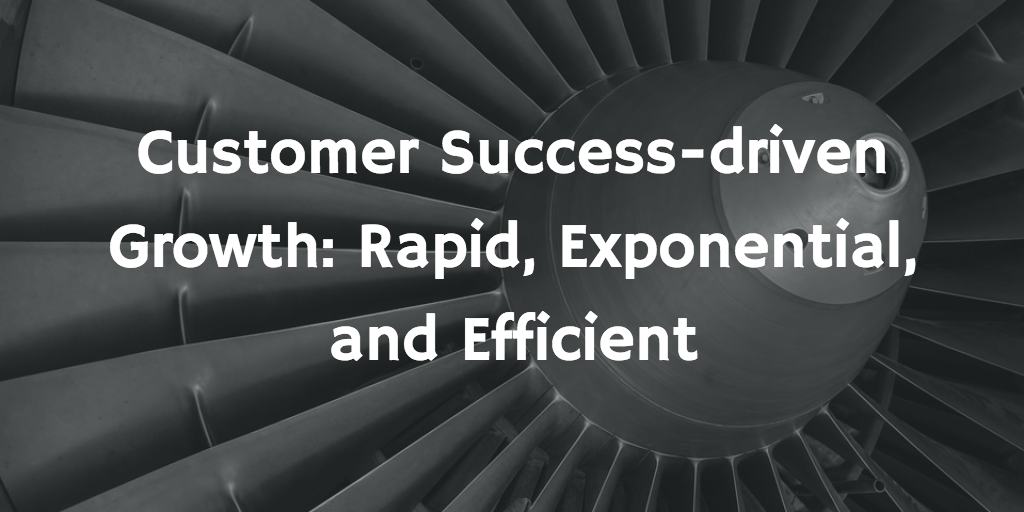 Doing whatever you can, spending whatever you can spend, to acquire any and all customers – whether they’re a good fit long-term or not – is played out. That’s not a valid growth strategy anymore (it never really was).
Doing whatever you can, spending whatever you can spend, to acquire any and all customers – whether they’re a good fit long-term or not – is played out. That’s not a valid growth strategy anymore (it never really was).
Today, Investors, Boards, Executives, and Startup Founders are all looking for rapid, exponential, and efficient growth. And yes, you can actually have all three of those.
In fact, there’s no more efficient – and done correctly, rapid and exponential – growth than growth within and from your existing customer base.
And the key to unleashing the power of this growth engine is Customer Success.
I even wrote a post that illustrates just how much of an impact Customer Success-driven Growth can have not just on Revenue expansion, but literally on the value of your company!
Let’s dig into what Customer Success-driven Growth is…
Customer Success as a Growth Engine
Customer Success-driven Growth – seeing Customer Success not as a way to make customers “happy,” but as a true Growth Engine – is all about expansion (upsells, add-ons, land and expand, viral expansion, etc.), but in a way that absolutely requires a baseline focus on the customer’s success.
Customer Success is when your customers achieve their Desired Outcome through their Interactions with your company.
The actual process of moving customers toward their ever-evolving Desired Outcome is called Customer Success Management.
Customer Success-driven Growth is growth – upsells, cross-sells, customer advocacy, viral expansion, etc. – that occurs as part of the customer’s evolution and success. As customers succeed and evolve, their relationship with you should evolve and grow as well.
Through Customer Success-driven Growth, account expansion happens in a predictable, scalable way that is a part of the customer’s journey through Success Milestones.
However, historically within Customer Success (yes, it’s old enough to say historically), it was said that Renewal and Expansion happen because a customer is successful; but that’s not quite accurate.
The reality is…
Expansion and Renewal are Part of a Customer’s Success
For customers to achieve their ever-evolving Desired Outcome, they’ll need to stay past a renewal, and they’ll very likely need to consume more of our core product, adjacent products, services, etc., so we say Expansion and Renewal are part of the customer’s success.
Through a combination of effective orchestration (managing expectations and teeing-up expansion opportunities early in the lifecycle), operationalization, and proactive intervention (three of the 8 elements of Customer Success Management), customers that achieve a Success Milestone with a logical expansion opportunity attached – and that are on a positive Success Vector – will take the upsell when it’s presented.
The key to making customer expansion work in a way that is customer-positive at scale is knowing exactly what expansion offer to present to the customer and when to do it.
This means knowing – for each customer segment – exactly what Success Milestones have associated expansion opportunities and knowing when customers will hit those Success Milestones.
It also means understanding how to short-circuit the customer’s journey to that Success Milestone by offering training, consulting, add-ons, etc.
Done correctly…
Customer Success Leads to Truly Predictable Revenue
It doesn’t get more predictable than being able to look at your existing customers, say these 100 customers will reach this Success Milestone in the next month, that milestone has a logical expansion opportunity associated with it, the value of that upsell is $1000/ARR, and the percentage of customers that should take the upsell based on their Success Vector is 90%.
That means, for that cohort, you’ll add $90k/ARR next month. Then, by combining the expansion value of all of the milestone cohorts, you can give an accurate prediction of the revenue you’ll generate from our existing customers.
Now that’s actual, real predictable revenue.
Something that needs to be addressed, however, is…
Management by Objectives vs. Expansion Quotas
When you can build a revenue forecast model based on actual customer Success Vectors, then you can manage against that rather trying to force the issue through expansion quotas.
You can say “according to Success Vectors, this cohort should deliver $90k/ARR in the next month.”
When you have Success Vector in place, internal expansion quotas are not needed, which means you won’t have Account Managers trying to shove products down a customer’s throat when they aren’t ready for it, don’t need it, or are otherwise not in a place where that is the logical next step.
Rather, you can create Objectives to manage against, essentially saying “this is the expected expansion from these cohorts in the next 30, 60, or 90 days and if we hit that, it means you simply did your job.”
However, if you miss that mark, it means the customer didn’t hit that Success Milestone, because if they had, according to Success Vector analysis, they would have taken the upsell. So that’s a fail on Customer Success Management; not that they didn’t make the upsell, but since the customer who you thought would reach that milestone obviously didn’t.
So there’s no need to quota on expansion; instead, use Success Vector-based projections to manage the success – or failure – of your Customer Success Management (including Account Managers, Expansion Resources, etc.) org.
Customer Success-driven Growth is the way to get rapid, exponential, and efficient growth in a customer-positive (and, ultimately, sustainable) way.



